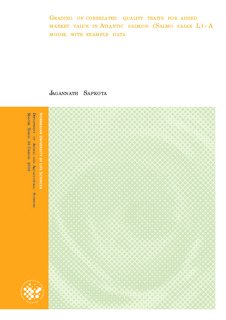| dc.description.abstract | The quality of the Atlantic salmon (Salmo salar L.) at the time of harvest affects the economic value and is in addition to body weight generally determined by the body composition and carcass quality traits, such as fillet colour and fat content. However, the method of grading on the basis of these quality traits is limited due to the lack of implemented technology. Currently, fish are therefore being graded according to their gutted body weight although different quality grade of pigment and fat content along with body weight are possible. Hence, the objectives of the study were (I) to determine the effect of present body weight based grading system on the frequency distribution of the quality traits fillet fat and fillet colour,(II) to study the effect on the frequency distribution of different quality classes of grading with respect to both body weight, fillet fat and fillet colour and (III) To study the added value if some premium could be fetched for grading fish in to top quality classes. Data were requested from SalmoBreed AS, Norway representing their 2001 year class. Total numbers of fish were 5316. Among them, 4331 (81.5%) fish were sexually immature and 985 (18.5%) were maturing. The sexual maturing fish were omitted from the data. The samples of 2634 of the non-maturing fish (1074 males and 1560 females) were used for the study. The traits recorded at harvest were sex, length (cm), round body weight (gm), gutted body weight (gm), pigment (ppm) and fillet fat content (%).The mean round body weight of the males was only 3.1% heavier than the females and average gutted body weight of males was 3.4% greater than females. The average fat and pigment content of male fish were only marginally higher than of the females. The mean value of gutted body weight, fillet pigment and fat content were found 2.89 kg, 6.74 ppm and 12.6% respectively in the sampled population. Fish with increasing body weight showed increasing value of pigment (r=0.51), fat (r=0.41), and increasing filet fat was associated with increasing pigment (r=0.55). A model was formulated to grade the Atlantic salmon in different quality groups based on fillet fat and pigment content and three models were given to calculate some anticipated premium for different quality grades based on fat content, pigment and gutted body weight. They were Revenue 1 (Rev 1), Revenue 2 (Rev 2) and Revenue 3 (Rev 3). In Rev 1, quality grading was not practiced. In Rev 2, grading on fillet fat and fillet pigment and in Rev 3, body weight, fillet fat and pigment were considered. For Rev 2 and 3, two alternatives were used. Different alternatives represent the different level of threshold value and premium percentage. Average revenue per kg fish for Rev 2 was 1.2% (Alt 1) and 1.0% (Alt 2) higher than Rev 1 whereas average revenue per kg fish for Rev 3 (Alt 2) was 1.22% higher than Rev 3 (Alt 1). When quality grading based on fillet fat and pigment content, the worst quality fish (HF.LP) got 25% less price whereas the best quality fish (LF.HP) got 30% extra price per kg gutted body weight than the medium quality (MF.MP). Moreover, when the grading based on fillet fat content, pigment and body weight, the best quality group (LF.HP) fetch 33.4% more price while worst quality group (HF.LP) got 29.7% less price as compared to the medium quality (MF.MP) fish. Both producers and consumers could be benefited if grading is conducted on the basis of these quality traits. However, at present there is no implemented technology to prove such grading with respect to different quality traits. When technology is available it is possible to offer different quality classes and answer will be acquired on the premium that can be achieved. | en_US |
